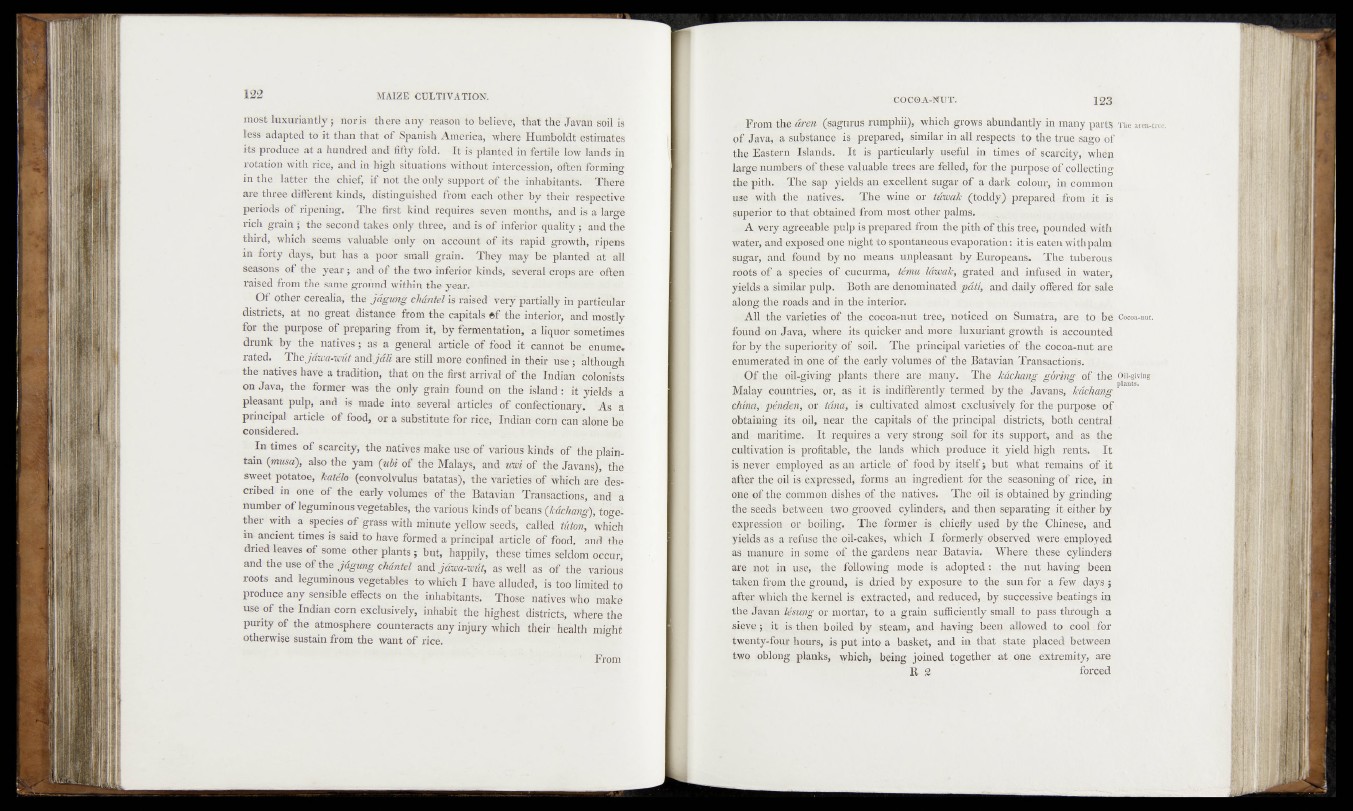
most luxuriantly;- noris there any reason to believe, that the Javan soil is
less adapted to it than that of Spanish America, where Humboldt estimates
its produce at a hundred and fifty fold. It is planted in fertile low lands in
rotation with rice, and in high situations- without intercession, often forming
in the latter the chief, if not the only support of the -inhabitants. There
are three different kinds, distinguished from each other by their respective
periods of ripening. The first kind requires seVern months, and is a large
rich grain f the second takes only three, and is of inferior quality; and the
third, which- seems valuable only on account of its rapid growth, ripens
in forty days, but has a. poor small grain-. They may be planted # -all
seasons of the year ; and of the two inferior kinds, several-crops are often
raised from the same ground, within the year. -
Of qther cereaha, the jdgrng chdntelis raised' v o y partially in particular
districts, at no great distance from the capitals ef the interior, and mostly
for the purpose of preparing from it, by fermentation, a liquor sometimes
drunk by the natives ; as a general article of food it cannot be enume,
rated. The jaiwa-tmt andjdU are still more confined: in their use; although
the natives have a tradition, that on the first arrival of the Indian1 cBlhwists
on Java, the former was the only grain found on the isl&ndr it yields a
pleasant pulp, and is made into several- articles of confectionary. As a
principal article of food, or a substitute for rice; lYidian-corn can alone be
considered.
In times of scarcity, the natives make use of various kinds" of the plain-
tain (wiMsa); also the yam (tibi o f the Malays, and imi of the Javans), the
sweet potatoe, Jcatelo (convolvulus batatas), the varieties of which- are des*
eribed in one ©f the early volumes- of the Batavian* Transactions, and a
number of leguminous vegetables, the various kinds of hearts (Mchhrig'f, togel
ther with a species of 'grass with minute yellow seeds, 'called afto«/'wfiieh
hv ancient times is said to have formed a principal article of food, and the
dried leaves of some other plants; but, happily, these times selifotti odour;
and the use of the jdgung ck&ntel and jdwoWU, as welt as of the various
roots and leguminous vegetables to which I have alluded,’is too limited-to
produce any sensible effects on the inhabitants. - Those natives who make
use of the Indian com exclusively, inhabit the highest districts, where the
puntyof the atmosphere counteracts any injury which their-health- might
otherwise sustain from the want of rice.
From
- From the d r e n (sagur<us rumphii), which grows abundantly in many parts The areu-t
off Java;.:a substance is prepared, similar in all respects to the true sago of Y
the Eastern Islands’.'« ’ It is particularly-useful, in times of scarcity, when
large numbers-of these valuable trees are felled, for the purpose of Collecting
thepifchvs .The &ap';yield§ an-excellent sugar n f a dark, colour, in common
use with the natives. The wine -or tdwak (toddy) prepared from it is
superior to that obtained from most other palms. .
A-very agreeable pulp is prepared, from the pith of this tree, pounded with
water, and exposed one night to spontaneous evaporation: it is eaten with palm
sugar, --and found by no! means unpleasant by Europeans. The tuberous
roots of ;a species of cucurma, tenvu Idtmk, grated and infused, in water,
yields a similar pulp. Both are denominated part, and daily offered; for sale
alofig the roads and in the interior1.
All the varieties of the cocoarnut ,-tree, noticed on Sumatra,. are to bd Cocoa-nut.
found k>n Java, where its quicker and more _ luxuriant growth is accounted
for by the1 superiority of soil. The principal-varieties of the cqcoai-nut are
enumerated in- one oft the, early- volumes of [the Batavian Transaction's. - .
,: Of the'oUrgiv&og-plants -there are many* The ledchang gbring of 'the on-giving
Mjalayicountries, ©r, as it is indifferently. termed ;by the, Javans, Jcdehang
china, pendenupv tana, is cultivated almost exclusively for the purpose of
obtaining its oil, near-,the .capitals of the principal districts; both central
and maritime, rlt requires'a very strong soil for its support;«'and as the
cultivation is profitable, the lands which produce it yield high rents. It
is, never employed as an article of food,-by itself jg but what remains of it
after the oil is expressed# forms.an ingredient for the seasoning of rice, in
ope of fheKOommon dishes joft the natives. The oil is obtained by grinding
thesseeds between--.two grooved cylinders, and then separating itj,eith_Cr by
expression or-boiling. The former is , chiefly used by the Chinese, and
yields as a refuse the oil-cakes, which I formerly- Observed were employed
as, manurei in somejoft the gardens near Batavia. Where, these cylinders
are not in v^e;- -the following mode is adopted * the -nut having been
taken fropi the ground, is dried by exposure to the sun for a few daysj
after which,the kernel is extracted, and reduced,-_by.successive beatings in
the Javan Jeswijg1 or mortar, to a grain sufficiently small to. pass through 'a
sieve; . it is then boiled by steam, and having been allowed to cool [for
twenty-four hours, is put into a basket and in that state- placed between
two oblong planks, which, being joined together at one extremity, are
E % forced